Rural development is a straightforward notion that presents challenges when it comes to implementation. The program’s primary objective is to enhance and advance the economies of rural areas that are facing extreme poverty.
Furthermore, it underscores the significance of tackling numerous urgent challenges in rural economies that are hindering progress and enhancing these regions.
Rural Development in India: Fresh Perspectives
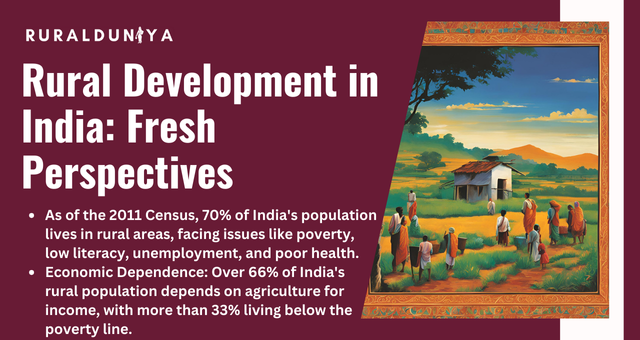
Rural development is a plan to improve rural economies and societies. According to the 2011 Census of India, 83.3 percent of the country’s total population of 121 million people reside in rural areas. Consequently, almost 70% of India’s populace resides in rural regions.
The rural communities exhibit prevalent poverty, low levels of literacy and income, high rates of unemployment, and inadequate nutrition and health conditions. Historically, development focused on the improper utilisation of natural resources, such as forestry and agriculture.
Today, the process of urbanisation and the shift in global industrial networks have significantly altered the characteristics of rural areas. The development of rural areas continues to be the central focus of the country’s overall growth.
Over 66% of the nation’s population relies on agriculture as their primary source of income, and over 33% of rural India remains below the poverty threshold. Hence, it is imperative for the government to be efficient and furnish adequate infrastructure to enhance their quality of life.
Community Development Programme
Initially, the primary focus for development was placed on agriculture, industry, communication, education, health, and related areas. Subsequently, it was recognised that faster development can only be achieved if the government’s efforts are effectively supported.
On March 31, 1952, the Community Projects Administration was established under the Planning Commission to oversee community development initiatives.
The community development programme, initiated on October 2, 1952, was a significant milestone in the development’s history of rural areas. This scheme had numerous modifications and was overseen by various Ministries.
Rural Development Benefits
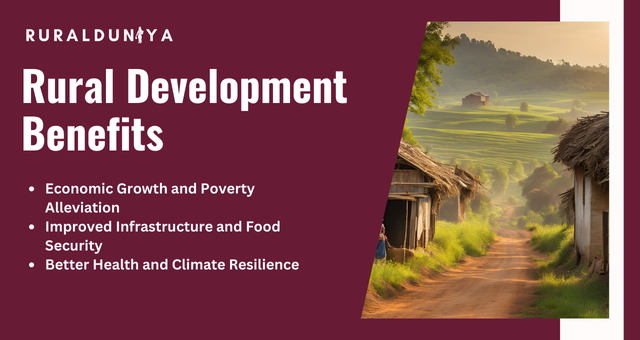
The advantages of development include-
- The stimulation of general economic growth through the utilisation of rural resources and the potential of the rural workforce.
- Alleviates poverty through the generation of job prospects and the augmentation of income levels in rural regions.
- Enhances food security by fostering agricultural efficiency and guaranteeing availability of adequate and nourishing food.
- Enables the construction and improvement of essential infrastructure, including roads, electricity, sanitation, and communication networks.
- Enhances the availability of healthcare services, resulting in improved health outcomes and decreased death rates.
- Enhances resistance to the effects of climate change by implementing sustainable agriculture methods and taking proactive actions to prepare for disasters.
Rural Development Budget 2024-25
The budget of the Ministry of Rural Development has been increased to Rs 1.77 lakh crore for the fiscal year 2024-25, which is a 12 percent increase from the previous year’s budget of Rs 1.57 lakh crore.
However, in comparison to the revised estimates, a mid-year review of expenditure conducted by the ministry, which amounted to Rs 1.71 lakh crore, shows a three percent increase.
Introduce initiatives to enhance employment opportunities in rural areas, establish sufficient agricultural infrastructure, and prioritise the development of infrastructure, resulting in improved roads and connectivity.
Rural Development Key Issues
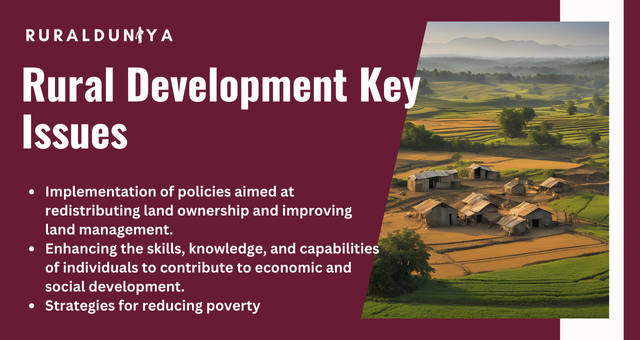
Here are several significant concerns with development:
- Implementation of policies aimed at redistributing land ownership and improving land management.
- Enhancing the skills, knowledge, and capabilities of individuals to contribute to economic and social development.
- Strategies for reducing poverty
- Insufficient education
- Insufficient industrialization
- Infrastructure development
Rural Development Project
It is crucial to address the requirements of rural India and strive for its comprehensive advancement in order to enhance the Economy.
The following are development projects that have been implemented in India as part of Corporate Social Responsibility.
- The Holistic Rural Development Project (HRDP)
- HCL Samuday
- Holistic Villages Development
- Community Infrastructure and Rural Development
- Project Saakar
Rural Development Programmes in India
List of development programmes for rural areas in India are –
| Name of Progarmme | Implemented by | Year |
| Firka Development | Madras Government | 1948 |
| Etawah Pilot Project | Albert Mayor | 1948 |
| Nilokheri Experiment | S. K.Dey | 1948 |
| Community Development Programme (CDP) | Government of India | 1952 |
| National Extension Service | NES | 1953 |
| Community Development Block | CDB | 1954 |
| Panchayati Raj Democratic Decentralization | Panchayati Raj | 1957 |
Rural Development Schemes
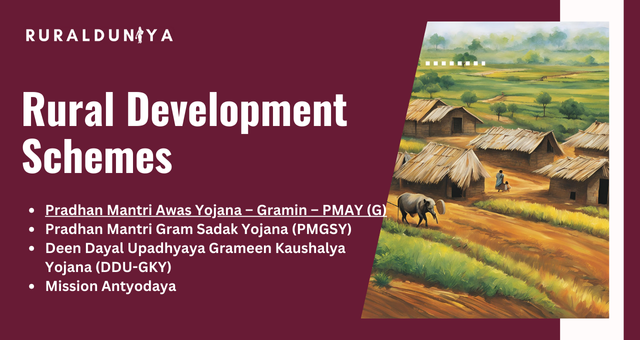
The implementation of numerous development initiatives aims to enhance the quality of life for individuals residing in rural areas.
- Pradhan Mantri Awas Yojana – Gramin – PMAY (G)
- Pradhan Mantri Gram Sadak Yojana (PMGSY)
- Deen Dayal Upadhyaya Grameen Kaushalya Yojana (DDU-GKY)
- Mission Antyodaya
- National Social Assistance Programme (NSAP)
- Saansad Adarsh Gram Yojana (SAGY)
- Aajeevika – National Rural Livelihoods Mission (NRLM)
- Shyama Prasad Mukherji Rurban Mission (SPMRM)
Rural Development Department
The Ministry of Rural Development consists of two distinct departments:
- Department of Rural Development
- Department of Land Resources
The MoRD is responsible for coordinating and implementing development and welfare initiatives in rural areas. It plays a crucial part in the overall development plan of the country.
The Ministry’s goal and mission are centred around achieving sustainable and inclusive growth in rural India.
This will be accomplished through a comprehensive plan that aims to eradicate poverty by creating more livelihood opportunities, establishing a social safety net, and improving infrastructure to support economic progress.
Rural Development Stocks

Best rural development investments are –
- Agrochemicals and Fertilisers: The demand for fertilisers and agrochemicals will be boosted by increased rural incomes and assured Minimum Support Prices (MSPs), which would help manufacturers in these sectors.
- Hybrid seeds: The utilisation of hybrid seeds to improve agricultural output provides prospects for companies that specialise in genetically modified seeds.
- Rural Infrastructure: The government’s emphasis on developing rural roads presents chances for financially stable enterprises in the road building industry.
- Financial Inclusion: The increased purchasing power in rural areas stimulates the need for financial services, creating opportunities for Non-Banking Financial Companies (NBFCs) and Microfinance Institutions (MFIs) to flourish.
- Healthcare extension: The extension of the National Health Plan requires healthcare companies to provide their services, such as diagnostics and testing labs, in remote areas.
Rural Development Jobs
Rural jobs in India, especially in CSR, NGOs, and government ministries, are vital to socioeconomic improvement. CSR roles usually entail sustainable development efforts, although NGOs advocate for and facilitate grassroots development.
Development initiatives are managed by government agencies, creating planning, execution, and oversight jobs. These sectors strengthen rural communities’ skills, infrastructure, and services, supporting inclusive growth nationwide.
Takeaway
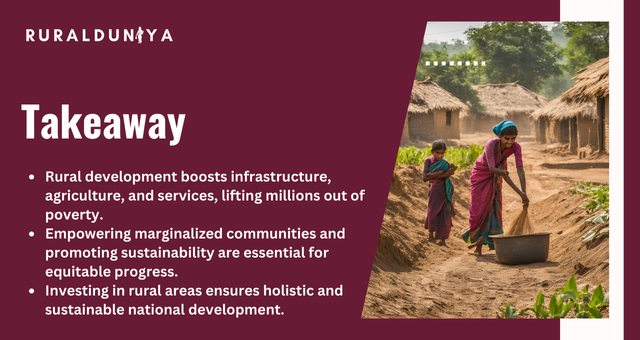
Rural development is crucial to India’s progress and prosperity. Development programmes may bring millions out of poverty and boost economic growth by boosting infrastructure, agricultural production, and access to healthcare and education.
Inclusive development in rural India requires empowering marginalised communities, encouraging sustainability, and developing social cohesion. Investing in development of rural area is essential for sustainable and holistic development as the nation seeks equitable progress.
FAQs
What are the important questions of rural development?
How important is credit in rural development? Describe agricultural marketing? Why does sustainable livelihoods require agricultural diversification? What are some agricultural marketing barriers?
What are the 3 significance of rural development?
It emphasises education, public health, women’s empowerment, infrastructure, and jobs.
What is the scope of rural development?
Agriculture was its main priority, but education, business, infrastructure, and social development are today.
What is the principle of rural development?
Specialised people provide expertise, and governmental or institutional budgets provide funding.

Nishank is a social impact enthusiast with a solid foundation in public policy, micro-enterprise, and agribusiness. Growing up in a farmer’s family has given him a profound connection to rural communities, fueling his passion to empower people towards self-reliance. He completed his undergraduate studies at the Delhi University and earned a master’s degree in Rural Management from National Institute of Rural Development & Panchayati Raj in Hyderabad.



